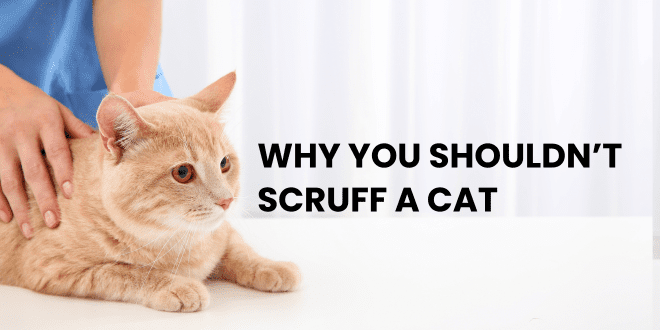
Scruffing has been a common practice in cat handling for a long time. It’s the method of cat restraint most veterinary professionals were originally taught. Scruffing is where the cat is grasped by the loose skin on the back of the neck. Even though this restraining technique has been widely used for so long, it’s essential to learn why it should be avoided in most situations. There are more humane methods for handling and controlling a cat.
What is Scruffing?
There are different levels of scruffing, ranging from a gentle hold to a firm grasp of the skin at the back of the neck, depending on whether a cat requires mild, moderate, or severe restraint. Sadly, scruffing has also been used to lift and carry a cat. Typically, the hind feet are also supported, however, in some instances, the cat may be left with the bulk of the body weight dangling in the air during transport.
Scruffing is often used to completely immobilize a cat where the neck is tightly grabbed, the hind feet are held, and the cat is stretched out for examination or some other procedure.
The argument for scruffing is that it supposedly mimics how kittens go limp when the mother cat picks them up this way. Unfortunately, a human can’t replicate the specific amount of pressure a mother cat uses, as well as other body language signals from mom to kitten. Additionally, kittens are only scruffed during their first few weeks of life. The young kittens, when held this way, reflexively freeze, and curl up their legs. During the first few weeks of life when kittens aren’t very mobile, this ability for the mother cat to pick up her kittens quickly, allows her to efficiently move them if she senses danger or if a kitten strays too far. This reflex in kittens diminishes as they grow.
What’s Wrong with Scruffing?
It can be painful and distressing. This can range from discomfort to outright pain. Scruffing can create fear and may create a negative association with the person who did the scruffing, or the environment where the cat has the experience. It can erode trust and the cat may start to become fearful of any type of handling.
Scruffing is often misused as a training method for disciplining a cat. This is an ineffective and inhumane attempt at training. The cat won’t associate scruffing with the unwanted behavior but will associate the distressing experience with the person doing the scruffing. Training by punishment does nothing to teach the cat the desired behavior. The proper method of training is to identify the reason for the behavior so you can supply what the cat needs. When you use a positive, force-free training technique, it sets the cat up to succeed and strengthens the bond.
Scruffing may lead to increased aggression. Scruffing may put a cat in a defensive position where he feels he must protect himself by biting or scratching.
Better Alternatives to Scruffing
To avoid having to scruff your cat to wrestle him into the carrier for a trip to the veterinary clinic, follow these steps to train your cat to be comfortable with the carrier and travel:
- Leave the carrier out. Place the carrier somewhere neutral in your home (not near the litter box or feeding station). Place a folded towel inside to make it more inviting as a place to nap.
- Use treats. Begin by leaving treats near the carrier and then eventually on top and inside. This will encourage your cat to explore the carrier at his own pace and receive a reward for getting closer.
- Close the carrier door. When your cat is comfortable going in and out of the carrier, you can briefly close the door when he’s in there, then open it again and offer an immediate reward.
- Lift the carrier. With your cat inside the carrier, gently lift it and walk around the room. This will help your cat get more comfortable with the movement. Place the carrier back down, open the door, and offer a reward.
- Trial Run in the Car. First get the cat comfortable with being in his carrier in the car. Don’t turn the engine on the first few times. When you feel the cat is ready, start the engine and let the cat get used to that sensation. The next step is to do some trial runs in the car where you just go on short trips.
- Create comfort. Your cat may feel more comfortable if there’s a light towel draped over the carrier. Spritz the towel lightly with Feliway. Don’t play loud music while in the car. Use a soft tone of voice as you drive to reassure your cat.
- Be patient. Go at your cat’s pace. Training may take time but it will hopefully make future trips to the veterinary clinic less stressful for both you and your cat.
At the Veterinary Clinic
- Don’t pull the cat out of the carrier. When you place the carrier on the exam table, open the carrier door and give your cat a few minutes to adjust. The cat may walk out of the carrier on his own. If he does step out of the carrier, give him time to investigate the room. If the cat remains in the carrier, you can remove the top (if using a kennel style). This way, your cat can remain in the bottom half for most of the exam.
- Towels are helpful. If the cat must be removed from the carrier, a towel can be gently placed over him rather than scruffing. There are various towel restraint methods that can be used with cats. The one your veterinarian chooses will be based on what part of the cat’s body needs to be visible. Your veterinarian and veterinary technicians are familiar with the type of wrapping techniques. When using a towel wrap restraint method, care must be taken to not wrap so tightly that it causes the cat to have difficulty in breathing. Many cats will also feel less anxious if they can hide their head beneath a towel or blanket. If you visit a Fear-Free certified veterinary clinic, they will be well trained in low-stress, force-free handling techniques.
- Use treats. During an exam, having treats such as Churu, or one your cat prefers, may provide enough of a positive distraction so the veterinarian can perform whatever exam or procedure is needed with minimal stress to the animal. For some cats, distractions such as toys, feathers, pheromone spray, or catnip work well too.
- Follow the cat’s lead. Some cats feel more comfortable being on the cat parent’s lap, on the floor, or being held. What matters is that the handling method used is the least stressful to the cat while being safest for all involved (cat, veterinarian, technician, and cat parent).
- Gentle holding. If the cat is frightened or showing aggression and must be picked up and carried, being securely wrapped in a towel while having his head covered and body completely supported is the best method.
- The security of hiding. Towels and blankets can be the best source of security when at the veterinary clinic. They allow the cat to feel hidden and they protect the person doing the handling from injury.
Pay Attention to What the Cat Needs
When you need to handle a cat who is fearful or highly stressed, take a moment and pay attention to what the cat’s body language is saying. You’ll get clues as to what might de-escalate the situation. Pause before jumping right into handling to determine if offering a treat, a toy distraction, allowing the cat to hide under a towel, lowering the lights, or some other gentle method will create an environment where the cat doesn’t have to resort to self-defense.
Here’s a video from the late Dr. Sophia Yin, showing how even a feral cat can be examined without scruffing.

Need More Information?
For more information on cat behavior and training, refer to the best-selling books by Pam Johnson-Bennett. Pam’s books are available at bookstores and online. We’ve included links to Amazon here on our website.


